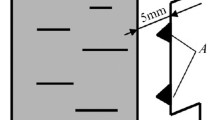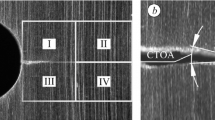We describe the analysis and identification of a network of surface cracks on the basis of processing of digital images. A three-dimensional analysis has been performed by a combination of two measured parameters: the length and depth of a crack. On the basis of processing of a limited number of data, the system can analyze cracking of the surface of a roll of a continuous slab-casting machine. Theoretical prerequisites and experimental results are presented.









Similar content being viewed by others
References
A. Persson, S. Hogmark, and J. Bergström, “Temperature profiles and conditions for thermal fatigue cracking in brass die casting dies,” J. Mater. Proc. Tech., 152, No. 2, 228–236 (2004).
S. Osterstock, C. Robertson, M. Sauzay, et al., “Stage I surface crack formation in thermal fatigue: a predictive multi-scale approach,” Mater. Sci. Eng. A., 528, No. 1, 379–390 (2010).
G. S. Pisarenko, N. S. Mozharovskii, and E. A. Antipov, Resistance to Force and Temperature Actions of Refractory Materials [in Russian], Naukova Dumka, Kiev (1974).
S. G. Psakh’e, E. V. Ruzhich, E. V. Shil’ko, et al., “On the influence of the state of interfaces on the character of local displacements in fracture-block and interface media,” Pis’ma Zh. Tekh. Fiz., 31, Issue 16, 80–87 (2005).
P. V. Yasnii, P. O. Marushchak, I. B. Okipnyi, et al., Scientific Foundations of the Increase of the Thermal Fatigue Resistance of Stainless Steel by Nanostructurization and Controlled Multiple Cracking of Surface Layers. Final Report of the Ukrainian–Russian Scientific Technological Project (0109U005863) [in Ukrainian], Pulyui Ternopil National Technical University, Ternopil (2010).
H. Uijtdebroeks, R. Franssen, D. Vanderschueren, and P. M. Philippe, “Integrated on-line work roll surface observation at the SIDMAR HSM,” in: Proc. of the 44th MWSP Conf., (September 8–10, 2002, Orlando), XL (2002), pp. 899–908.
P. O. Marushchak, Development of Methods for the Evaluation of the Technical State and Remaining Life of Operated Rolls of Continuous Slab-Casting Machines [in Ukrainian], Author’s Abstract of the Doctoral Thesis (Technical Science), Karpenko Physicomechanical Institute, Lviv (2010).
X. Wu and L. Xu, “Computer aided evaluation of thermal fatigue cracks on hot-work tool steel,” in: Proc. of the 6th Int. Tooling Conf. (September 10–13, 2002, Karlstad, Sweden), Karlstad (2002), pp. 781–792.
V. E. Panin (editor), Physical Mesomechanics and Computer-Aided Design of Materials [in Russian], Vol. 1, Nauka, Novosibirsk (1995).
P. V. Yasniy, P. O. Maruschak, S. V. Panin, and P. S. Lyubutin, “Strain stages and regularities of static fracture of 25Cr1Mo1V steel damaged by a network of thermal fatigue crack,” in: Proc. of the 13th Int. Conf. “Mesomechanics 2011” (July 6–8, 2011, Vicenza, Italy), Vicenza (2011), pp. 84–87.
P. V. Yasnii, P. O. Marushchak, I. V. Konovalenko, and R. T. Bishchak, “Computer analysis of surface cracks in structural elements,” Fiz.-Khim. Mekh. Mater., 44, No. 6, 83–88 (2008); English translation: Mater. Sci., 44, No. 6, 833–839 (2008).
V. I. Rabinovich, M. A. Rozov, and L. S. Timonen, “Object and problems of technical diagnostics,” Avtometriya, No. 1, 27–34 (1965).
P. O. Maruschak and I. V. Konovalenko, “Measurement of strain of materials by analysis of digital images of the surface,” Zav. Lab. Diagnost. Mater., 76, No. 6, 55–60 (2010).
P. O. Maruschak, S. R. Ignatovich, A. P. Pilipenko, and R. T. Bishchak, “Influence of the operation time under thermocycling on fracture of 25Kh1М1F steel under static loading,” Zav. Lab. Diagnost. Mater., 77, No. 4, 57–60 (2011).
P. O. Marushchak, I. V. Konovalenko, and R. T. Bishchak, “Diagnostics of the state of the surface of metallurgical equipment,” in: Proc. of the Int. Scientific Conf. “Mathematical Problems of Technical Mechanics” [in Ukrainian], Dniprodzerzhynsk State Technical University, Dniprodzerzhynsk (2009), pp. 167–169.
P. Maruschak and R. Bishchak, “Localized deformation of heat–resistant steel with multiple cracks at mesolevel,” Proc. of the 12th Int. Conf. “Advanced Materials and Technologies and European Doctorate in Physics and Chemistry of Advanced Materials” (August 27–31, 2010, Palanga), Palanga (2010), p. 34.
M. Kachanov, “ Elastic solids with many cracks and related problems,” in: J. Hutchinson, and T. Wu (editors), Advances in Applied Mechanics, Academic Press (1994), pp. 256–426.
A. Srivastava, V. Joshi, and R. Shivpuri, “Computer modelling and prediction of thermal fatigue cracking in die-casting tooling,” Int. J. Wear, 256, 38–43 (2004).
P. O. Marushchak and I. V. Konovalenko, Method for the Determination of the Surface Density of Cracks [in Ukrainian], Patent of Ukraine No. 40741, Publ. 27.04.2009, Bull. No. 8.
P. O. Marushchak, I. V. Konovalenko, and S. V. Panin, “Identification of the location of elements of a network of multiple cracking,” Proc. of the Int. Conf. “Calculus Mathematics and Mathematical Problems of Mechanics” (August 31–September 4, 2009) [in Ukrainian], Pidstryhach Institute for Applied Problems of Mechanics and Mathematics, Lviv (2009), pp. 157–159.
M. Zhuravel,’ L. M. Svirs’ka, O. Z. Student, R. A. Vorobel,’ and H. M. Nykyforchyn, “Automated determination of grain geometry in an exploited steam-pipeline steel,” Fiz.-Khim. Mekh. Mater., 45, No. 3, 23–29 (2009); English translation: Mater. Sci., 45, No. 3, 350–357 (2009).
O. Z. Student, B. P. Rusyn, B. V. Kysil’, M. I. Kobasyar, T. P. Stakviv, and A. D. Markov, “Quantitative analysis of structural changes in steel caused by high-temperature holding in hydrogen,” Fiz.-Khim. Mekh. Mater., 39, No. 1, 22–28 (2003); English translation: Mater, Sci., 39, No. 1, 17–24 (2003).
P. Yasniy, P. Maruschak, I. Konovalenko, et al., “Multiple cracks on continuous caster rolls surface: a three-dimensional view,” in: Proc. of the 4th Int. Conf. “Processing and Structure of Materials” (May 27–29, 2010, Palić), Palić (2010), pp. 7–12.
P. Yasniy, P. Maruschak, Y. Lapusta, et al., “Thermal fatigue material degradation of caster rolls' surface layers,” Mech. Adv. Mater. Struct., 15, No 6–7, 499–507 (2008).
I. Sevostianov, G. Agnihotri, and J. F. Garay, “On connections between 3-D microstructures and their 2-D images,” Int. J. Fract., 126, 65–72 (2004).
A. E. Huespe, A. Cardona, and V. Fachinotti, “Thermomechanical model of a continuous casting process,” Comput. Meth. Appl. Mech. Eng., 182, 439–455 (2000).
P. Yasniy, P. Maruschak, I. Konovalenko, and R. Bishchak, “Diagnostics of thermal fatigue cracks on continuous caster rolls surface,” Mechanika, 17(3), 251–254 (2011).
R. T. Bishchak, P. O. Marushchak, and I. V. Konovalenko, “Ultrasonic diagnostics of surface multiple cracking,” Visn. Kharkiv. Nats. Univ. Sil’s’k. Hospodar. Im. P. Vasylenka, 94, 73–77 (2010).
P. O. Marushchak, R. T. Bishchak, and I. B. Okipnyi, “Influence of the multiple cracking of a heat-resistant steel on parameters of magnetic nondestructive testing,” in: Proc. of the 12th Int. Conf. “New Structural Steels, Alloys and Methods of Treatment of Them for Increasing the Reliability and Durability of Articles” (October 6–8, 2010, Zaporizhzhya) [in Ukrainian], Zaporizhzhya National Technical University, Zaporizhzhya (2010), pp. 68–69.
H. M. Nykyforchyn and O. T. Tsyrulnyk, “In-service degradation diagnostics of low-alloyed steels and aluminum alloys properties by electrochemical methods,” Ultragarsas, 64, No. 1, 46–49 (2009)
Author information
Authors and Affiliations
Corresponding author
Additional information
Translated from Fizyko-Khimichna Mekhanika Materialiv, Vol.48, No.1, pp.54–63, January–February, 2012.
Rights and permissions
About this article
Cite this article
Marushchak, P.O., Konovalenko, I.V. Computer evaluation of the depth of thermomechanical fatigue cracks according to their length. Mater Sci 48, 54–64 (2012). https://doi.org/10.1007/s11003-012-9472-3
Received:
Published:
Issue Date:
DOI: https://doi.org/10.1007/s11003-012-9472-3




